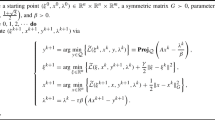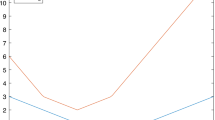Abstract
The Barzilai–Borwein (BB) gradient method is efficient for solving large-scale unconstrained problems to modest accuracy due to its ingenious stepsize which generally yields nonmonotone behavior. In this paper, we propose a new stepsize to accelerate the BB method by requiring finite termination for minimizing the two-dimensional strongly convex quadratic function. Based on this new stepsize, we develop an efficient gradient method for quadratic optimization which adaptively takes the nonmonotone BB stepsizes and certain monotone stepsizes. Two variants using retard stepsizes associated with the new stepsize are also presented. Numerical experiments show that our strategies of properly inserting monotone gradient steps into the nonmonotone BB method could significantly improve its performance and our new methods are competitive with the most successful gradient descent methods developed in the recent literature.



Similar content being viewed by others
References
Akaike, H.: On a successive transformation of probability distribution and its application to the analysis of the optimum gradient method. Ann. Inst. Stat. Math. 11(1), 1–16 (1959)
Barzilai, J., Borwein, J.M.: Two-point step size gradient methods. IMA J. Numer. Anal. 8(1), 141–148 (1988)
Cauchy, A.: Méthode générale pour la résolution des systemes déquations simultanées. Comp. Rend. Sci. Paris 25, 536–538 (1847)
Dai, Y.H.: Alternate step gradient method. Optimization 52(4–5), 395–415 (2003)
Dai, Y.H., Fletcher, R.: Projected Barzilai–Borwein methods for large-scale box-constrained quadratic programming. Numer. Math. 100(1), 21–47 (2005)
Dai, Y.H., Huang, Y., Liu, X.W.: A family of spectral gradient methods for optimization. Comp. Optim. Appl. 74(1), 43–65 (2019)
Dai, Y.H., Kou, C.X.: A Barzilai–Borwein conjugate gradient method. Sci. China Math. 59(8), 1511–1524 (2016)
Dai, Y.H., Liao, L.Z.: \(R\)-linear convergence of the Barzilai and Borwein gradient method. IMA J. Numer. Anal. 22(1), 1–10 (2002)
Dai, Y.H., Yuan, Y.X.: Alternate minimization gradient method. IMA J. Numer. Anal. 23(3), 377–393 (2003)
Dai, Y.H., Yuan, Y.X.: Analysis of monotone gradient methods. J. Ind. Manag. Optim. 1(2), 181–192 (2005)
De Asmundis, R., Di Serafino, D., Hager, W.W., Toraldo, G., Zhang, H.: An efficient gradient method using the yuan steplength. Comp. Optim. Appl. 59(3), 541–563 (2014)
Di Serafino, D., Ruggiero, V., Toraldo, G., Zanni, L.: On the steplength selection in gradient methods for unconstrained optimization. Appl. Math. Comput. 318, 176–195 (2018)
Dolan, E.D., Moré, J.J.: Benchmarking optimization software with performance profiles. Math. Program. 91(2), 201–213 (2002)
Fletcher, R.: On the Barzilai–Borwein method. In: Qi, L., Teo, K., Yang, X. (eds.) Optimization and Control with Applications, pp. 235–256. Springer, Boston (2005)
Fletcher, R.: A limited memory steepest descent method. Math. Program. 135(1–2), 413–436 (2012)
Hestenes, M.R., Stiefel, E.: Method of conjugate gradient for solving linear system. J. Res. Nat. Bur. Stand. 49, 409–436 (1952)
Forsythe, G.E.: On the asymptotic directions of the s-dimensional optimum gradient method. Numer. Math. 11(1), 57–76 (1968)
Frassoldati, G., Zanni, L., Zanghirati, G.: New adaptive stepsize selections in gradient methods. J. Ind. Manag. Optim. 4(2), 299–312 (2008)
Friedlander, A., Martínez, J.M., Molina, B., Raydan, M.: Gradient method with retards and generalizations. SIAM J. Numer. Anal. 36(1), 275–289 (1998)
Golub, G.H., Van Loan, C.F.: Matrix Computations, 4th edn. Johns Hopkins University Press, Baltimore, Maryland (2013)
Gonzaga, C.C., Schneider, R.M.: On the steepest descent algorithm for quadratic functions. Comp. Optim. Appl. 63(2), 523–542 (2016)
Huang, Y., Dai, Y.H., Liu, X.W., Zhang, H.: Gradient methods exploiting spectral properties. Optim. Method Softw. 35(4), 681–705 (2020)
Huang, Y., Dai, Y.H., Liu, X.W., Zhang, H.: On the asymptotic convergence and acceleration of gradient methods. J. Sci. Comput. 90, 7 (2022)
Huang, Y., Liu, H., Zhou, S.: Quadratic regularization projected Barzilai–Borwein method for nonnegative matrix factorization. Data Min. Knowl. Disc. 29(6), 1665–1684 (2015)
Jiang, B., Dai, Y.H.: Feasible Barzilai–Borwein-like methods for extreme symmetric eigenvalue problems. Optim. Method Softw. 28(4), 756–784 (2013)
Liu, Y.F., Dai, Y.H., Luo, Z.Q.: Coordinated beamforming for miso interference channel: complexity analysis and efficient algorithms. IEEE Trans. Signal Process. 59(3), 1142–1157 (2011)
Raydan, M.: On the Barzilai and Borwein choice of steplength for the gradient method. IMA J. Numer. Anal. 13(3), 321–326 (1993)
Raydan, M.: The Barzilai and Borwein gradient method for the large scale unconstrained minimization problem. SIAM J. Optim. 7(1), 26–33 (1997)
Tan, C., Ma, S., Dai, Y.H., Qian, Y.: Barzilai–Borwein step size for stochastic gradient descent. In: Advances in Neural Information Processing Systems, pp. 685–693 (2016)
Davis, T.A., Hu, Y.: The university of Florida sparse matrix collection. ACM Trans. Math. Softw. 38(1), 1–25 (2011)
Wang, Y., Ma, S.: Projected Barzilai–Borwein method for large-scale nonnegative image restoration. Inverse Probl. Sci. En. 15(6), 559–583 (2007)
Wright, S.J., Nowak, R.D., Figueiredo, M.A.: Sparse reconstruction by separable approximation. IEEE Trans. Signal Process. 57(7), 2479–2493 (2009)
Yuan, Y.X.: A new stepsize for the steepest descent method. J. Comput. Math. 24(2), 149–156 (2006)
Yuan, Y.X.: Step-sizes for the gradient method. AMS IP Stud. Adv. Math. 42(2), 785–796 (2008)
Zhou, B., Gao, L., Dai, Y.H.: Gradient methods with adaptive step-sizes. Comp. Optim. Appl. 35(1), 69–86 (2006)
Acknowledgements
The authors would like to thank the associate editor and the anonymous referees for their valuable comments and suggestions. This work was supported by the National Natural Science Foundation of China (Grant Nos. 11701137, 11631013, 12071108, 11671116, 11991021, 12021001), the Strategic Priority Research Program of Chinese Academy of Sciences (Grant No. XDA27000000), Beijing Academy of Artificial Intelligence (BAAI), China Scholarship Council (No. 201806705007), Natural Science Foundation of Hebei Province (Grant No. A2021202010), and USA National Science Foundation (Grant Nos. 2110722, 1819161).
Author information
Authors and Affiliations
Corresponding author
Ethics declarations
Conflict of interest
All data generated or analysed during this study are available from the corresponding author on reasonable request.
Additional information
Publisher's Note
Springer Nature remains neutral with regard to jurisdictional claims in published maps and institutional affiliations.
Rights and permissions
About this article
Cite this article
Huang, Y., Dai, YH., Liu, XW. et al. On the acceleration of the Barzilai–Borwein method. Comput Optim Appl 81, 717–740 (2022). https://doi.org/10.1007/s10589-022-00349-z
Received:
Accepted:
Published:
Issue Date:
DOI: https://doi.org/10.1007/s10589-022-00349-z




